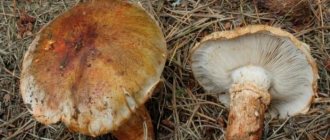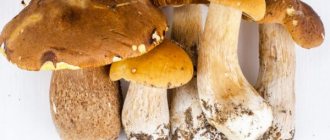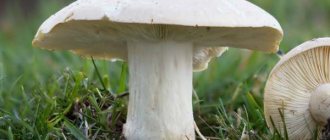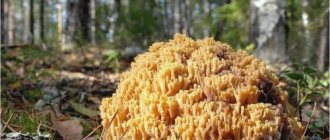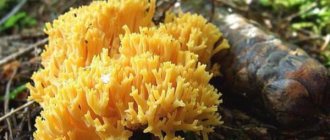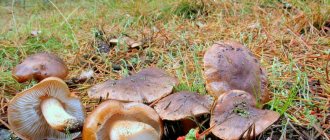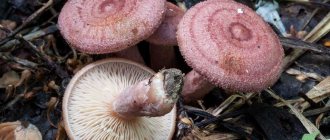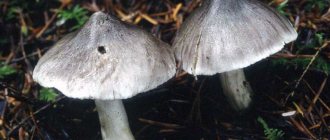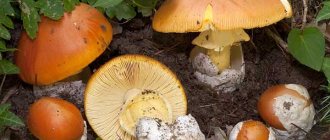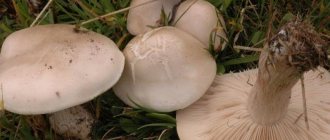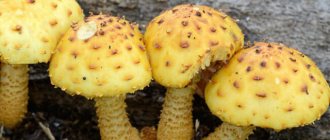Purple row is considered a conditionally edible mushroom. It's not difficult to find. The specimen grows in parks and forests, as well as in private plots. The mushroom should absolutely not be eaten raw. After proper processing, the specimen is suitable for consumption and can become a component of your favorite dishes.
Other names are blueleg, titmouse, Lepista nuda or violet lepista.
Every mushroom picker knows that row mushrooms can be eaten only after preliminary heat treatment. This does not mean that the specimen is poisonous. There are no particularly dangerous toxins in the mushroom. But if the specimen is eaten unprocessed, it promises serious intestinal upset and stomach pain.
The row is very bright and looks like its poisonous counterparts. That is why it is important to know the characteristic features of an individual thoroughly.
How to recognize purple row mushrooms
The cyanosis has a very unusual appearance. Her cap is flat, slightly convex and fleshy, with uneven edges. The cap reaches 6-15 cm in diameter, and is covered with thin and wide plates on the underside.
Both the upper and lower surfaces of the cap change color depending on age. Young bluefish have a bright purple color, but with age they fade and become light purple. The even, smooth stem of the mushroom has the same shade. The height of the leg usually reaches about 8 cm; near the base it thickens slightly.
When cut, the violet row has dense and elastic lilac-colored pulp. A recognizable feature of cyanosis is the presence of a pleasant and light fruity smell.
Medicinal properties of violet row
The value of cyanosis lies not only in its taste characteristics. Violet row has medicinal properties; it contains vitamins B1 and B2, zinc and copper, manganese and organic acids. Blueberry is rich in vegetable protein, but 100 g of its pulp contains only about 19 kcal.
When eaten, the species is capable of:
- relieve inflammatory processes and fight fungal diseases due to its antibiotic properties;
- reduce blood sugar levels;
- improve immunity and increase the body's resistance to viral diseases;
- support healthy stomach and intestinal function.
Also, the purple row is beneficial for the nervous system, as it relieves symptoms of chronic fatigue and helps avoid overwork. It is useful to consume nutritious cyanosis during the recovery period after illnesses and operations; the protein-rich pulp strengthens the body's strength.
Cooking method
Violet row is a mushroom that you eat with pleasure. It can be fried and dried, as well as pickled and boiled. It is advisable to boil it for about fifteen minutes before preparing the row. And then use it for cooking.
In addition to its calorie content and usefulness, it has healing substances. It is used to make antibiotics.
Various countries consider the rower to be inedible, but this is not true. Of course, you can’t eat it raw, as the body may be poisoned. Boil it and all the bad substances will go away.
How to prepare a purple row
In cooking, there are many recipes for preparing violet row for food. However, first of all, fresh mushrooms must be pre-treated:
- Immediately after collection, the cyanosis is cleaned of plant debris, and then soaked in salt water for 1-3 days. The fluid must be drained and replaced with a new one every 3 hours.
- After soaking, the purple row is boiled in salt water for half an hour. In addition to salt, it is recommended to add a bay leaf, a couple of buds of dried cloves and a few black peppercorns to the solution.
Important! The boiled pulp must be thoroughly rinsed again in cold water. The water from under the purple row must be drained; the broth cannot be used for food purposes, it is dangerous for the body.
How to pickle violet rows
Pre-treated purple rows can be pickled for long-term storage. A popular recipe for a purple row is as follows:
- Place 2 kg of boiled mushrooms in a large saucepan and fill them with 1.5 liters of water.
- Add 3 large tablespoons of salt and 4 tablespoons of sugar to the water, then bring the solution to a boil and cook the cyanosis for another 10 minutes.
- Pour 6 large tablespoons of table vinegar into boiling water, add 3 bay leaves, several black peppercorns and 3 buds of dry cloves.
- The solution is kept on low heat for about 10 minutes, then turned off.
Boiled purple rows in a fragrant marinade are poured into sterilized jars without waiting for them to cool, and then rolled up tightly and stored.
How to salt purple rows
Another simple way to prepare mushrooms is a recipe for pickling purple row, which allows you to preserve the benefits and taste for a long time:
- Fresh cyanosis is cleaned of dirt and soil, washed properly, soaked and boiled.
- A glass or wooden container for pickling is scalded with boiling water, and then the treated cyanosis is placed inside, caps down.
- Each small layer of rows is generously sprinkled with coarse salt; if desired, you can add herbs and spices to your taste - pepper, cloves, bay leaves, dill seeds.
- When the container is filled to the top, you will need to close it with a lid and place a heavy load on top, the so-called oppression.
The container with mushrooms is placed in a dry and cool place with a temperature no higher than 5 °C. Salted purple rows will be ready in a month and will be a wonderful cold appetizer on the autumn table.
How to fry purple rows
You can not only salt or marinate the blue mushroom; a popular method of preparing the purple row is to fry the mushroom. First of all, the mushrooms are cleaned of adhering debris and soaked in salt water, and then boiled in the standard way for half an hour.
Algorithm:
- Dry the boiled purple rows with a paper towel, and then spread them in a thin layer on a heated frying pan greased with vegetable oil.
- Fry the mushrooms for 10 minutes over medium heat, stirring occasionally.
- After 10 minutes, salt the cyanosis to taste, add pepper, herbs and spices if desired.
- After this, reduce the heat to low and simmer the purple row in the frying pan for another 2-3 minutes.
Ready-made fried rows can be served with potatoes or as an addition to any meat and vegetable dish. To improve the taste, you can add a little herbs, garlic or onion to the mushrooms, and also pour in a couple of spoons of sour cream.
How to make soup from purple rows
Among the dishes from the purple row, a very tasty and unusually colored soup is gaining interest. The cooking recipe is as follows:
- About 400 g of fresh rows are soaked for 3 days.
- Prepared mushrooms are poured into 2 liters of fresh water and about 3 g of citric acid is added to it.
- The mushrooms are boiled for 20 minutes, then washed and lightly dried, and the broth is drained.
- To prepare the soup, cut 5 potatoes, peeled carrots and onions into small pieces.
- Boiled mushrooms are lightly fried in vegetable oil until a golden brown crust appears on them.
- Place all ingredients in a saucepan with 1.5 liters of water, add mushrooms and cook until the vegetables are fully cooked.
A couple of minutes before turning off the heat, the soup should be salted to taste, after which the dish can be served.
Growing at home and in the country
Rowing can be grown at home and in open ground. The first harvest appears approximately 1.5 years after planting. In the future, you can harvest several times a year.
Growing bluelegs in the garden
To cultivate the plant in your dacha, you need to create a comfortable environment. To do this, you need to prepare compost and leave it for about 30-40 days. You need to mix 12 kg of rotten straw with 8 kg of organic fertilizer (bird droppings, cow or horse manure).
Mushrooms can be planted in spring or autumn at temperatures not lower than +15°C. To do this, spread the compost on the beds and place it in a box or bag. After planting, you need to regularly moisten the soil with water and mycelium. After about 2-3 weeks, purple areas will appear. They need to be sprinkled with damp soil to a depth of 5 cm, without covering the crop. Mycelium will appear on the soil within 2-3 weeks. It remains to maintain the optimal humidity level.
The lilac-legged rower tolerates winter well. When the temperature drops below +5°C, the beds need to be covered with bags, and a layer of leaves or straw 10 cm thick should be laid on top. In the spring, the bags can be removed when the temperature warms up to +10°C.
Growing bluelegs indoors
This type of mushroom can be grown indoors. The main conditions for a successful harvest are optimal humidity, temperature +10-15°C, good lighting and ventilation. If the mushrooms get little light, they dry out and die.
Benefits and harm to the body
Thanks to its valuable composition, violet row is able to have a beneficial effect on the body.
In particular, the mushroom:
- helps with inflammation and bacterial processes;
- improves digestion and helps improve metabolism;
- increases endurance and makes the immune system more resistant to viruses and infections;
- normalizes blood composition and can be beneficial for diabetes;
- replenishes strength during increased stress or protein deficiency in the diet.
However, under certain circumstances, purple rowing can harm the body. It should not be consumed if you have chronic diseases of the stomach and intestines; the mushroom is too difficult to digest and will aggravate the condition.
Cyanosis can also have a negative effect if collected in an environmentally unfavorable area. Mushroom pulp perfectly absorbs toxins from the soil and air, so mushrooms growing near roads and industrial facilities contain too many toxic substances.
What can the purple row be confused with?
At first glance, it seems that the bright purple or lilac color of the mushroom makes it completely unique in appearance. But this is not so, there are many purple-legged rowers and false look-alikes, and the mushroom can easily be confused with both edible and toxic look-alikes.
Bluefoot, or Lepistal-footed
This conditionally edible mushroom is similar to blue mushroom in external structure; it has a fleshy, slightly convex cap with a lamellar lower surface and a purple stem. However, there are also important differences - the cap of the mushroom is much lighter and closer to white. In addition, false violet row, or blueleg, grows in warm subtropical regions, mainly in fields and meadows, and can be found from mid-spring.
Lepista violet
Another lamellar, conditionally edible mushroom grows in temperate climates and is found mainly in forests. The cap of the violet lepista is convex, its edges are uneven. However, the color of the mushroom is not purple, but rather pinkish-brown or whitish. In addition, the pulp of this type of lepista produces a distinct violet aroma when broken.
Lilac lacquer
The mushroom belongs to the category of conditionally edible and grows in temperate climates from early summer to mid-autumn. The varnish is similar to the violet row in its shade; at a young age it is bright purple, as it matures it turns pale and fades. The mushroom also has a flattened, fleshy cap with a slight convexity in the center, and the underside of the cap is covered with thin plates.
However, a photo of a purple false mushroom makes it possible to distinguish it from a real mushroom. The difference lies primarily in size - the lacquer usually reaches no more than 5 cm in diameter and belongs to miniature mushrooms.
Purple web spider
This conditionally edible mushroom from the spider family of the same name grows in coniferous and deciduous forest plantations in temperate climates. It is similar to the young purple rower in the shape of its cap, but usually has a darker color - deep purple or brownish, the same color is the plate on the underside of its cap.
The purple flesh of the spiderwort produces a nutty, rather than a fruity, aroma. The stem of the mushroom noticeably thickens in the lower part, and you can also see traces of a blanket on it, similar to a light cobweb.
Important! Purple cobweb is a mushroom listed in the Red Book, so you can rarely find it in forests.
White and purple web spider
This mushroom from the Spider web family is classified as inedible and cannot be eaten. The convex or bell-shaped cap of the mushroom reaches 8 cm in diameter, and the cobweb can rise above the ground on a stalk by 8 cm. The color of the mushroom is pale lilac or silver-lilac, in old cobwebs it is off-white or slightly yellowish.
You can distinguish the inedible mushroom from the purple rower not only by its shade, but also by its pulp - in the cobweb mushroom it is soft, quickly turns brown when cut, and at the same time emits a noticeable smell of mold.
Goat's web
Another inedible mushroom is distinguished by a convex hemispherical cap up to 6-12 cm in diameter and a thick short stalk with a thickening near the ground. The goat's web has a bluish-purple tint to the legs and cap, and its flesh is grayish-purple. The peak of fruiting occurs at the end of summer, and you can find the mushroom in coniferous and mixed plantings in the middle zone until the beginning of October.
You can distinguish the poisonous purple row mushroom from the real edible one both by color and shape, as well as by smell. An inedible mushroom emits an unpleasant aroma of acetylene and does not at all evoke the desire to taste the pulp.
Pure mycena
The hemispherical cap of a miniature inedible mushroom can reach 4 cm in diameter, and mycena can rise 9 cm above the ground. It vaguely resembles a row, but is much thinner and smaller in size, the color of mycena is more grayish than purple, sometimes pale brown. Its flesh is also gray or pale gray, watery and with a distinct unpleasant odor. When broken, the mycena secretes milky juice in very large quantities.
Pure mycena differs from the purple row not only in its external features. It is difficult to confuse the species due to different periods of growth - the row is an autumn mushroom, while the inedible mycena is found in temperate climates from early spring to the end of June.
Where do bluelegs grow?
Blueleg is predominantly a southern mushroom. But in general it is found throughout Russia, including in the Moscow region.
It can be found most often in meadows or pastures. They grow in colonies, so when you see them, you can’t go wrong. You will come across small “islands” in the form of a circle or “path”.
And sometimes you can see them very close. Podavniki love soils rich in organic matter. Therefore, they often appear near farms, houses and even in compost ditches.
In the forest, on the contrary, you will rarely see this species; they prefer well-lit spaces. But, if there are several colonies in the thicket, then under deciduous trees.
Collection rules
You need to go to the forest for the purple row during the period of its maximum fruiting - in early September and until mid-October, before the onset of the first frost.
Since the edible mushroom has a strong resemblance to its conditionally edible and poisonous counterparts, special care should be taken when collecting:
- The color of the cap and stem should be exactly the same as in the photo of the purple row mushroom, bright purple for young fruiting bodies and lavender for adults.
- There should be no visible pattern on the cap, and there should be no “web” on the stem, which is the remains of a ring.
- When cut, the row should be bright purple or lilac, and the smell of the edible pulp is always pleasant.
Attention! You need to collect cyanosis in clean forests located away from roads, factories and large cities. Only blueberries that grow in good environmental conditions bring health benefits.
Spreading
The row can be found in meadows among grasses.
Rowing of this species grows almost everywhere in relatively warm Russian regions, but, as already mentioned, it tolerates light frosts well.
It is best to look for it in light forests, on the edges and even in meadows. Bluelegs is practically never found in forests with dense vegetation.
She loves alkaline soils and humus. Therefore, it often grows quite openly near farms and pastures.
The mushroom usually grows in large colonies, in rows, hence the name. They usually begin to collect it closer to autumn, but in moist soil it bears fruit well in the summer. However, full harvest usually begins in September and ends late in November.
Often in a season it is possible to harvest even two crops in one place. You just need to not destroy the mycelium.
It is noteworthy that the purple-legged rower can be safely transported even in ordinary bags. The mushroom hardly crumbles.
